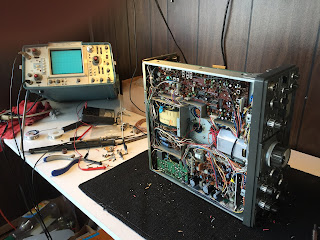 |
| Adding a downward expander cleans up your transmit audio. |
 |
| The Hershberger® Speech Processor Used by W1ZY in Kenwood Hybrids |
 |
| TS-520 Front Panel Modification Speech Processor Controls |
The enclosure is an electric guitar effects box procured on the internet. The chip is powered by a 9 Volt battery inside the box so that it can be used with any rig. Before getting into the install details, let's identify the sources of the components you'll need to perform this mod.
You can get the SSM2166 chip from Small Bear Electronics in Brooklyn, NY for $12. Remember, this is the same chip used in many W2IHY products, and costs as much as a 12-pack of beer. To save on shipping costs, look for components you'll need for this project on the Small Bear web site when ordering the SSM2216 chip--especially the four (4) potentiometers which need to be PC-mountable in order to ease installation of the circuit board into an enclosure.
 |
| SSM2166 Chip ($12) |
 |
| SSM2166 PC Board $12 |
I was motivated to mod the TS-830 when I noticed the large, blank space on its rear panel on the other side of which lay the rig's power transformer--the worst place to bring in audio lines. Nevertheless, this empty space appeared to be calling for the installation of a die cast Bud box fitted with XLR audio connectors. Having no Bud box on hand, I cut a hole and mounted several RCA jacks. This plate of jacks will be replaced by a Bud box from which I will route audio cables through the hole into the rig.
 |
| Template for Hole |
A template of the RCA plate was composed on graph paper, cut out and taped to the rear of the rig. Quick work with a Dremel produced a jagged hole rendered smooth with a few strokes of a hand file. Total time: 5 minutes.
 |
| TS-830S Audio Ports |
 |
| Mod Final Location |
Naturally, the coupling between the two transformers was so great that the perfboard was relocated to the IF board, mounted above it off two standoffs next to the spot where the microphone cable (MV1) is wired into the rig, This was a perfect place; there was no more hum in the transmit audio. And that's it for the machining needed for this mod.
 |
| Parts List SSM2166 Compressor/Downward-expander |
Wiring It Up
 |
| Rear of Mic Connector. |
Solder another shielded cable to an RCA jack on the rear panel, label it "AUDIO IN", and connect it to the primary of the isolation transformer on the perfboard. This RCA jack will be connected to the output of the SSM2166 processor box when you cable this thing up. We placed a 20 dB attenuation pad between the secondary of the isolation transformer and the microphone input of the rig (MV1) to be able to fine-tune the level of the incoming audio down to mic-level. Interestingly, this pad's design is based on a TS-830S modification presented by Kenwood to create a "phone patch" input to the rig.
 |
| Perfboard Mounted Above IF Board Contains isolation transformer and attenuation pad. |
Cabling up is a snap, requiring two everyday RCA patch cables. One goes from MIC OUT on the rig to the input of the processor box. And the other one goes from the output of the processor box to the "AUDIO IN" on the rig. NOTE: You can add additional devices--like an equalizer--between the output of the processor box and the rig if you want.
Realigning ALC and RF Speech Processing Circuits
Although this mod will work as is, you can really dial it in by recalibrating the ALC and RF speech processor stages in the TS-830. This mildly complicated procedure equalizes ALC meter deflection between unprocessed and processed states, and allows you to determine where ALC deflection begins on the MIC GAIN knob. There is no need to perform these calibrations after installing this modification. We only mention it to alert technically-minded readers of its possibility. The only reason I did it on the TS-830S is because, at the time, I was realigning the whole rig after repairing it.
Fully-assembled SSM2166 processor boxes are available at an exorbitant price.
BILL W1ZY
Although this mod will work as is, you can really dial it in by recalibrating the ALC and RF speech processor stages in the TS-830. This mildly complicated procedure equalizes ALC meter deflection between unprocessed and processed states, and allows you to determine where ALC deflection begins on the MIC GAIN knob. There is no need to perform these calibrations after installing this modification. We only mention it to alert technically-minded readers of its possibility. The only reason I did it on the TS-830S is because, at the time, I was realigning the whole rig after repairing it.
Fully-assembled SSM2166 processor boxes are available at an exorbitant price.
BILL W1ZY


















No comments:
Post a Comment